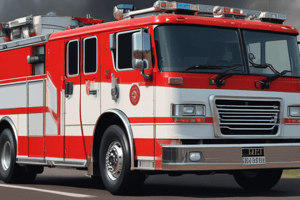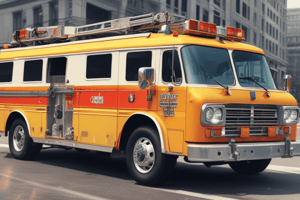Podcast
Questions and Answers
What is a crucial characteristic for emergency vehicle drivers?
What is a crucial characteristic for emergency vehicle drivers?
- Being positive and aware of other drivers (correct)
- Being aggressive and competitive
- Having a high level of physical strength
- Being an experienced mechanic
Why should emergency vehicle drivers plan their route and navigation?
Why should emergency vehicle drivers plan their route and navigation?
- To ensure they arrive at the scene first
- To avoid driving during rush hour
- To familiarize themselves with roads and traffic patterns (correct)
- To reduce fuel consumption
When should emergency vehicle drivers use lights and sirens?
When should emergency vehicle drivers use lights and sirens?
- Whenever they are driving
- Whenever they are lost
- Only during emergency situations (correct)
- Only during non-emergency situations
Why should emergency vehicle drivers maintain a safe following distance?
Why should emergency vehicle drivers maintain a safe following distance?
What should emergency vehicle drivers do when parking?
What should emergency vehicle drivers do when parking?
How do emergency vehicle drivers control their vehicle?
How do emergency vehicle drivers control their vehicle?
What is important to consider when braking in inclement weather?
What is important to consider when braking in inclement weather?
Why should emergency vehicle drivers avoid driving when significantly fatigued?
Why should emergency vehicle drivers avoid driving when significantly fatigued?
What should emergency vehicle drivers do when driving through standing water?
What should emergency vehicle drivers do when driving through standing water?
Why should emergency vehicle drivers use anti-lock brakes?
Why should emergency vehicle drivers use anti-lock brakes?
Flashcards are hidden until you start studying
Study Notes
Driver Characteristics
- Being diligent, cautious, and emotionally fit are important characteristics for emergency vehicle drivers
- Having a positive attitude and being aware of tolerance towards other drivers is crucial
- Physical fitness is essential, and drivers should avoid driving if they're taking medications that cause drowsiness or have a slow reaction time
- Drivers should not drive or provide care after consuming alcohol or being under the influence, and should avoid driving when significantly fatigued
Safe Driving Practices
- Plan your route and navigation, and become familiar with roads and traffic patterns in the area
- Avoid heavy traffic areas, construction zones, and congested areas
- Be aware of special facilities and locations in the area, such as medical facilities, airports, and stadiums
- Recognize and manage fatigue, and take regular breaks to rest and recover
Speed and Safety
- Always drive with caution and perform a risk-benefit analysis when using lights and sirens
- Use lights and sirens judiciously, and only for emergency situations
- Anticipate other drivers' actions and maintain a safe travel distance
- Avoid aggressive driving and don't accelerate through intersections
- Make eye contact with fellow drivers and use turn signals
Vehicle Operation
- Maintain a cushion of safety by keeping a safe following distance and scanning rearview and side mirrors
- Be aware of blind spots in the vehicle and use convex mirrors to assist in visualizing them
- Avoid backing up whenever possible, and use a spotter when necessary
- Use audible warning devices and backup alarms, and don't rely solely on backup cameras
Parking and Scene Safety
- Park efficiently and safely, considering terrain, traffic flow, and emergency vehicle access
- Avoid blocking movement of other emergency vehicles and keep warning lights activated
- Park uphill and upwind in cases of smoke or hazardous materials, and stay away from hazards like fires and downed wires
- Turn headlights off to avoid blinding oncoming traffic at night
Vehicle Control
- Control a vehicle by changing direction or speed, requiring continuous rolling contact between tires and road surface
- Evaluate road surface conditions, such as asphalt, gravel, or dirt roads, and adjust speed accordingly
- Take corners at a speed that allows for proper road position and avoids skidding or spinning
Braking
- Brake pressure control comes with experience and practice
- Type 1 and 3 vehicles have heavier feeling brakes than type 2 vehicles
- Certain heavy vehicles use air brakes with a different feel
- Use control braking to control vehicle movement and direction, and avoid braking while cornering
- Consider weather and road conditions, weight distribution, and vehicle type when braking
Inclement Weather
- Gradually slow down on wet roads to avoid hydroplaning
- Avoid traveling through standing water, and lightly tap the brakes to dry them after driving out of water
- Use anti-lock brakes by applying steady light pressure to dry the brakes
- Consider decreased visibility during fog, snow, or heavy rain, and slow down
- Use headlights during the day and night, and be cautious on icy or slippery surfaces
Driver Characteristics
- Diligence, cautiousness, and emotional fitness are crucial for emergency vehicle drivers
- A positive attitude and tolerance towards other drivers are essential
- Physical fitness is vital, and drivers should avoid driving while taking medications that cause drowsiness or slow reaction time
- Drivers must not drive or provide care while under the influence or significantly fatigued, and should avoid driving after consuming alcohol
Safe Driving Practices
- Plan routes and navigation to become familiar with local roads and traffic patterns
- Avoid heavy traffic areas, construction zones, and congested areas
- Be aware of special facilities and locations, such as medical facilities, airports, and stadiums
- Recognize and manage fatigue, and take regular breaks to rest and recover
Speed and Safety
- Always drive cautiously and perform a risk-benefit analysis when using lights and sirens
- Use lights and sirens judiciously, only for emergency situations
- Anticipate other drivers' actions and maintain a safe travel distance
- Avoid aggressive driving and don't accelerate through intersections
- Make eye contact with fellow drivers and use turn signals
Vehicle Operation
- Maintain a cushion of safety by keeping a safe following distance and scanning rearview and side mirrors
- Be aware of blind spots and use convex mirrors to assist in visualizing them
- Avoid backing up whenever possible, and use a spotter when necessary
- Use audible warning devices and backup alarms, and don't rely solely on backup cameras
Parking and Scene Safety
- Park efficiently and safely, considering terrain, traffic flow, and emergency vehicle access
- Avoid blocking movement of other emergency vehicles and keep warning lights activated
- Park uphill and upwind in cases of smoke or hazardous materials, and stay away from hazards like fires and downed wires
- Turn headlights off to avoid blinding oncoming traffic at night
Vehicle Control
- Control a vehicle by changing direction or speed, requiring continuous rolling contact between tires and road surface
- Evaluate road surface conditions and adjust speed accordingly
- Take corners at a speed that allows for proper road position and avoids skidding or spinning
Braking
- Brake pressure control comes with experience and practice
- Different vehicle types have different brake feels, such as Type 1, 2, and 3 vehicles, and certain heavy vehicles use air brakes
- Use control braking to control vehicle movement and direction, and avoid braking while cornering
- Consider weather and road conditions, weight distribution, and vehicle type when braking
Inclement Weather
- Gradually slow down on wet roads to avoid hydroplaning
- Avoid traveling through standing water, and lightly tap the brakes to dry them after driving out of water
- Use anti-lock brakes by applying steady light pressure to dry the brakes
- Consider decreased visibility during fog, snow, or heavy rain, and slow down
- Use headlights during the day and night, and be cautious on icy or slippery surfaces
Studying That Suits You
Use AI to generate personalized quizzes and flashcards to suit your learning preferences.




